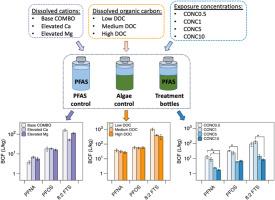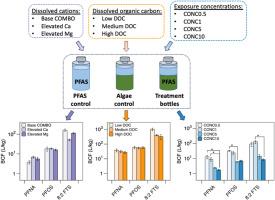溶解阳离子、溶解有机碳和暴露浓度对淡水藻类中全氟烷基和多氟烷基物质生物积累的影响
IF 7.3
2区 环境科学与生态学
Q1 ENVIRONMENTAL SCIENCES
引用次数: 0
摘要
全氟和多氟烷基物质(PFAS)因其持久性、毒性、生物蓄积潜力和相关的不良影响而引起全球关注。作为重要的初级生产者,淡水藻类构成了淡水水生生态系统食物网的基础。然而,关键环境因素对PFAS在淡水藻类中吸收和积累的影响尚未得到深入研究。本研究通过三个生物积累实验来评估溶解阳离子、溶解有机碳和暴露浓度对藻类中PFAS生物积累的影响。在所研究的14种PFAS中,7种长链PFAS倾向于在藻类中生物积累。升高的二价阳离子(Ca2+和Mg2+)和溶解的有机碳没有显著改变PFAS的藻类生物浓度因子(BCFs),这表明PFAS与环境因素和生物活性之间相互作用的复杂性。此外,增加每种PFAS的暴露浓度(0.5、1、5和10 μg/L)会增加藻类中PFAS的浓度,但降低BCF值。这表明,在未来的研究中,包括生态风险评估中,应重视生物燃料的应用。此外,氟端聚体磺酸(FTSs)未完全恢复,表明发生了生物转化。藻类是否在fts的生物转化中发挥作用并确定其作用机制有待进一步研究。研究关键环境因子对藻类中PFAS生物积累的影响,对于理解发生在最低营养水平并最终影响整个水生生态系统动态的生物积累过程至关重要。本文章由计算机程序翻译,如有差异,请以英文原文为准。


Effects of dissolved cations, dissolved organic carbon, and exposure concentrations on per- and polyfluoroalkyl substances bioaccumulation in freshwater algae
Per- and polyfluoroalkyl substances (PFAS) have attracted global attention because of their persistence, toxicity, bioaccumulation potential, and associated adverse effects. As important primary producers, freshwater algae constitute the base of the food web in freshwater aquatic ecosystems. However, the effects of key environmental factors on PFAS uptake and bioaccumulation in freshwater algae have not been thoroughly studied. In this study, three bioaccumulation experiments were conducted to evaluate the influence of dissolved cations, dissolved organic carbon, and exposure concentrations on PFAS bioaccumulation in algae. Among the 14 studied PFAS, seven long-chain PFAS tended to bioaccumulate in algae. Elevated divalent cations (Ca2+ and Mg2+) and dissolved organic carbon did not significantly change the algal bioconcentration factors (BCFs) of PFAS, suggesting complexity of the interactions among PFAS, environmental factors, and biotic activities. Additionally, increasing exposure concentrations (0.5, 1, 5, and 10 μg/L of each PFAS) increased PFAS concentrations in algae but decreased the BCF values. This indicated that attention should be paid to the application of BCFs in future studies, including ecological risk assessment. Moreover, fluorotelomer sulfonic acids (FTSs) were incompletely recovered, suggesting that biotransformation occurred. Further studies should be conducted to evaluate whether algae play a role in FTSs biotransformation and to determine the mechanisms. Studying the impacts of key environmental factors on PFAS bioaccumulation in algae is crucial for understanding the bioaccumulation processes that occur at the lowest trophic level and that eventually affect the dynamics of entire aquatic ecosystems.
求助全文
通过发布文献求助,成功后即可免费获取论文全文。
去求助
来源期刊

Environmental Pollution
环境科学-环境科学
CiteScore
16.00
自引率
6.70%
发文量
2082
审稿时长
2.9 months
期刊介绍:
Environmental Pollution is an international peer-reviewed journal that publishes high-quality research papers and review articles covering all aspects of environmental pollution and its impacts on ecosystems and human health.
Subject areas include, but are not limited to:
• Sources and occurrences of pollutants that are clearly defined and measured in environmental compartments, food and food-related items, and human bodies;
• Interlinks between contaminant exposure and biological, ecological, and human health effects, including those of climate change;
• Contaminants of emerging concerns (including but not limited to antibiotic resistant microorganisms or genes, microplastics/nanoplastics, electronic wastes, light, and noise) and/or their biological, ecological, or human health effects;
• Laboratory and field studies on the remediation/mitigation of environmental pollution via new techniques and with clear links to biological, ecological, or human health effects;
• Modeling of pollution processes, patterns, or trends that is of clear environmental and/or human health interest;
• New techniques that measure and examine environmental occurrences, transport, behavior, and effects of pollutants within the environment or the laboratory, provided that they can be clearly used to address problems within regional or global environmental compartments.
 求助内容:
求助内容: 应助结果提醒方式:
应助结果提醒方式:


